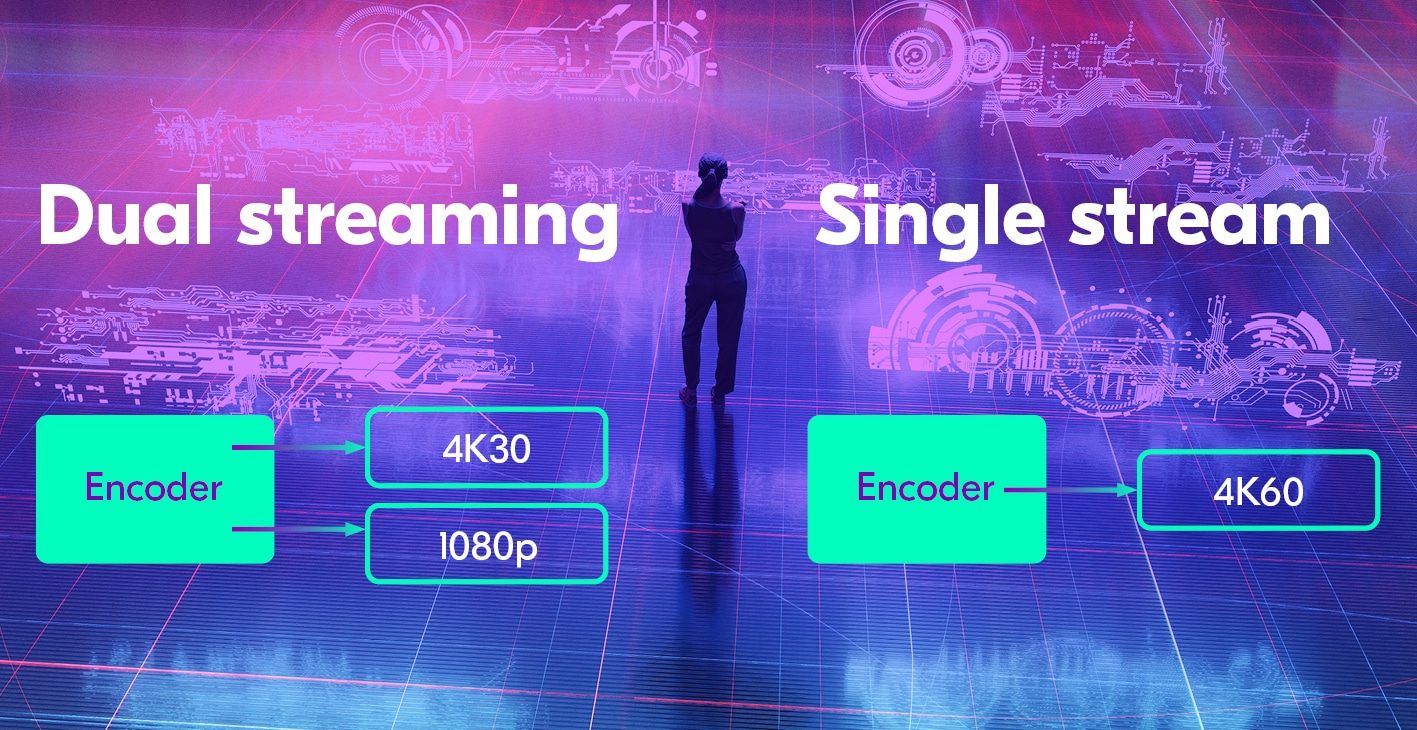May 21, 2024
Understanding dual streaming in the AVoIP realm

Imagine this scene.
You’re sitting at the center of a command-and-control room, orchestrating a flow of various high-quality audio-visual content streams, arriving from different sources. One stream is destined for a high-definition display within the control room, demanding a crisp 4K60 resolution. The other stream, on the other hand, is bound for a recording device in a remote location with limited bandwidth.
Now, what do you do? Would you use a single stream that requires two different encoders? Or is there a different, more sophisticated solution?
In this blog post, we explore the essence of the solution for the above situation: dual streaming. We explain dual streaming, its benefits, applications, and future.
What is dual streaming?
Traditionally, using a single stream in AVoIP, achieving these different streams would require two separate encoders: one for high quality; and another for lower quality – along with multiple cables and switches.
A single stream operates under the assumption that all receiving devices (encoders, decoders, monitors, etc.) can handle the same video quality. If they can’t, the system defaults to the lowest common denominator; it downgrades the entire AV stream to the lowest resolution acceptable by all destinations. This approach simplifies network demands but at the cost of optimal viewing quality and requires a set of encoders and cables for each format.
But dual streaming changes this dynamic. It allows the simultaneous transmission of two different formats—low-resolution content and high-resolution content—to two different destinations, ensuring that each destination receives the format best suited to its capabilities.
In contrast to the single streaming method, dual streaming simplifies the streaming process with a single encoder and cable. This consolidation results in significant savings on system and installation costs, simplifies the network architecture, and promotes ease of integration.
The rationale for dual streaming is simple yet compelling. High-quality video is always preferable, but it’s not always feasible, especially when dealing with constraints like cellular networks or distant destinations with limited bandwidth. In such cases, your content must go through numerous IP switches, necessitating compression and quality reduction for feasible transmission. Dual streaming elegantly bypasses this by sending the same visual content in different IP packets, tailored to the capabilities of each destination.
The applications of dual streaming
Dual streaming can be used in various application scenarios. In each of the following ones, dual streaming stands out as a versatile, cost-effective solution, ensuring that every destination receives the video quality suited to its specific requirements and constraints:
Command and control in high-stakes environments
Dual streaming becomes crucial in military or government command centers, where the junction of countless data sources meets limited bandwidth. Here, a single source needs to distribute the same signal to multiple endpoints, each capable of displaying different resolutions.
For instance, in a situation room, a commander might need to zoom into high-resolution feeds for detailed insights, while simultaneously recording at a lower resolution for archiving or remote monitoring.
Educational and global video distribution
Consider a classroom setting where students need to view high-quality videos. The same content, when transmitted globally, may face bandwidth constraints, making lower-resolution streaming necessary. Dual streaming allows for this versatility – high resolution for local, in-class viewing, and condensed formats for distant learners.
Broadcasting and media production
In a TV studio broadcasting a live sports event, the director may juggle multiple camera feeds. While all 50 camera angles are previewed in lower quality for quick selection, the chosen camera’s feed is streamed in high resolution for broadcast. This simultaneous dual streaming ensures efficient control and high-quality output.
Industrial and manufacturing surveillance
On a manufacturing floor, each machine might be equipped with a camera, feeding live operational data to the control room. While local monitoring demands high-resolution streams for detailed analysis, remote monitoring, perhaps via a smartphone, requires only a lower-resolution stream to check the overall status.
Technical considerations and network requirements
Understanding the technical and network considerations before implementing dual streaming is imperative for anyone looking to implement or optimize AVoIP solutions that are both resilient and efficient.
1. Network bandwidth and capacity
The backbone of dual streaming lies in the network’s bandwidth. It’s crucial to understand the capacity of the IP network being used for content distribution. The bandwidth dictates the maximum quality and quantity of streams that can be transmitted.
For instance, a single camera stream might be manageable, but adding more streams necessitates a careful evaluation of the network’s bandwidth. This is where network capacity plays a pivotal role – it must be robust enough to handle multiple AV streams without becoming a bottleneck.
2. Non-blocking switches
A non-blocking switch is essential in a dual streaming setup. It allows any source to reach any destination within the network, facilitating the transmission of multiple inputs to multiple outputs without interference. This requirement ensures that the network can handle a large volume of AV streams simultaneously, maintaining the integrity of each stream.
3. Quality of Service (QoS) protocol
In a network that handles diverse data types – from video to management information – the Quality of Service (QoS) becomes a key player. QoS protocols help prioritize certain types of data over others.
For example, in a virtual meeting, audio quality might take precedence over video quality to ensure clear communication. Properly implemented QoS ensures that the network effectively manages the priorities and flow of different data types, preventing issues like video freezing due to bandwidth competition.
4. Security and authentication
Alongside QoS, security protocols are paramount. Every device connecting to the network must undergo stringent authentication processes, typically involving usernames and passwords. This step ensures that only authorized devices can access and transmit data over the network. Encryption also plays a crucial role in protecting the integrity of the video content, allowing for selective encryption of different streams based on sensitivity and importance.
Conclusion, and the future of dual streaming
As we gaze into the future of AVoIP technologies, dual streaming stands as a significant milestone, as it plays a crucial role in AVoIP solutions. The principles and functionalities of dual streaming are becoming more integral, making AVoIP solutions more efficient and cost-effective, and serving as a stepping stone to more sophisticated streaming capabilities.
It is important to note that the convergence of AV and IT expertise is essential for the successful implementation and expansion of dual streaming technology. As for the future of streaming, dual streaming continues to evolve, promising to become an increasingly popular and indispensable tool in the realm of digital communication and broadcasting. It also paves the way for more advanced developments like triple streaming (which is more common in IP cameras), ultimately enhancing how we connect and communicate in an increasingly digital world.
In conclusion, dual streaming is a pivotal technology that enhances efficiency and lowers the system costs of digital streaming and communication, responding adeptly to the diverse needs of its users and setting the stage for future innovations in streaming technology.










